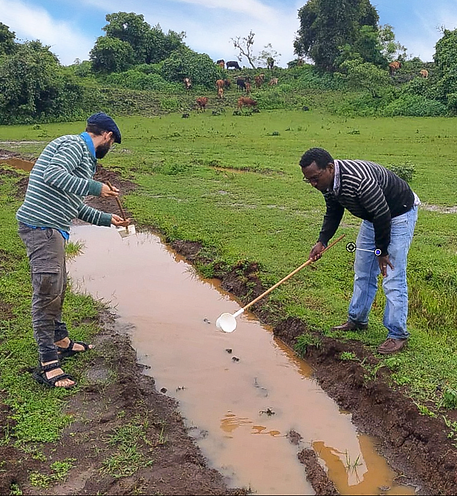AI is revolutionizing the fight against malaria
Our operations have taken us across sub-Saharan Africa, where our technology has been implemented and tested, demonstrating its impact in a variety of settings and environments. Through collaboration with some of the leading research organizations in the field, as well as governments and non-profit organizations, Zzapp is making a difference in the fight against malaria.

In collaboration with the ministry of health of São Tomé and Príncipe, we conducted an 8-month larviciding operation on the island of São Tomé, covering 240 square kilometers of both urban and rural areas, home to approximately 166,000 people. We succeeded in reducing the mosquito population by 75% and malaria incidence by 52%, at an average cost of $0.86 per person protected (PPP). The cost ranged from $0.44 PPP in urban areas to $1.41 PPP in rural areas. This suggests that in urban and semi-urban settings, where 60% of Africa’s population lives, our solution is twice as cost-effective as today’s leading method, distribution of bed nets. Read more about the results of this operation, in a peer-reviewed article from Malaria Journal.
52% reduction in
malaria cases
$0.44 per person in
urban areas
Up to twice as cost-effective as
bed nets

Obuasi,
Ghana
Our collaboration with the AGAMal malaria control company started in 2017, when an early version of our mobile app was used to cut the house spraying operation time by 20%, thanks to digitization of data-entry. AGAMal, a leading malaria control organization based in Ghana, has been conducting house spraying in the city since 2006, with impressive results. The organization became interested in control of mosquito breeding sites as a way to deal with an alarming trend of insecticide resistance.
In 2018, AGAMal conducted a randomized controlled trial that demonstrated the value of the Zzapp mobile app in identification of mosquito breeding sites. Two groups were tasked with mapping the same area, one using the mobile app and one using the industry accepted method. The app-guided group detected 28% more water bodies, with an estimated coverage of over 90% in built up areas.
In 2020, AGAMal launched a large-scale larviciding operation throughout the city of Obuasi, protecting a population of over 200,000 people. The Zzapp system was used to guide the operation, which reduced the mosquito population by over 60% in as little as three and a half months, compared to a control community. The cost of the operation was a mere US$0.2 per person protected, compared to US$5 for house spraying.
60%
less mosquitoes
+90%
detection
$0.2
cost per person
Compared to a control community, the operation reduced the mosquito population by over 60% in as little as three and a half months.

Zanzibar
In Zanzibar, the Zzapp system is being integrated as part of the Spatial Intelligence System (SIS), a collaboration employing drones for detection of mosquito breeding sites. The project is implemented by the Zanzibar Ministry of Health, and includes researchers from Aberystwyth University, the London School of Hygiene & Tropical Medicine, and the Liverpool School of Tropical Medicine.
Drones are a powerful tool for locating water bodies, especially in areas with limited access (such as wetlands). While they cannot detect water bodies hidden by vegetation or manmade structures, they can cover a lot of ground quickly, and reduce the manpower required for mapping.
The trial involves identification of water bodies from drone imagery, and transferring the data into the Zzapp system, to make it accessible to field workers through the mobile app. The drone-powered operation is being compared to traditional methods using simple GPS readers and ground surveys. The Zzapp system is also being used to guide 'ground truth' surveys, which will be used to evaluate the performance of the SIS and conventional methods.
The study is funded by the Bill and Melinda Gates Foundation, an important funder and opinion leader in the field of malaria research, through the Innovative Vector Control Consortium (IVCC).
Academic
collaboration
New drone
capabilities
Gates
Foundation
Drones are a powerful tool for locating mosquito breeding sites, especially in areas with limited access.

Ethiopia
In Finote Selam, Ethiopia, Zzapp has collaborated on several projects with the renowned ICIPE research center (International Centre of Insect Physiology and Ecology), to demonstrate the effectiveness of app-guided control of mosquito breeding sites.
The area is ideal for this method of intervention, for several reasons. Firstly, it is relatively densely populated, therefore every water body targeted protects a large number of people. In addition, many of the houses in the area are made out of mud, making house spraying less feasible. Lastly, one of the prevalent mosquito species in the area is Anopheles arabiensis, an outdoor-biting species less susceptible to house spraying and bed nets.
Working alongside Dr. Abebe Asale, an entomologist with vast expertise in alternative malaria control methods, Zzapp has gained theoretical and practical knowledge contributing to the development of the system.
App-guided
operations
Partnering
with ICIPE
Practical
knowledge
Zzapp has collaborated with the renowned ICIPE research center to demonstrate the effectiveness of app-guided control of mosquito breeding sites.

Mozambique
Mozambique has a significant malaria burden with over ten million cases reported annually. Malaria is the second leading cause of death in the country. In March 2022, Mozambique's National Malaria Control Program (NMCP), Goodbye Malaria, CISM and Zzapp launched a vector control pilot in Maputo.
Following the successful completion of this operation, Zzapp and Mozambique's NMCP are preparing to scale up activities across the country. The focus will be on urban areas where Zzapp's solution has demonstrated exceptionally high cost-effectiveness in combating malaria.